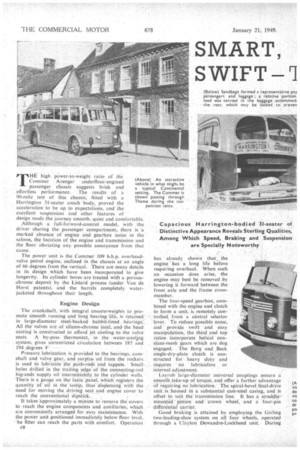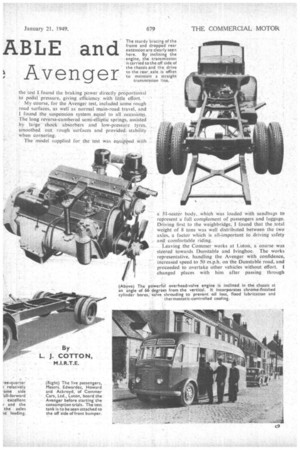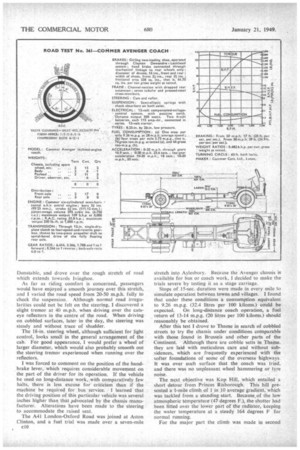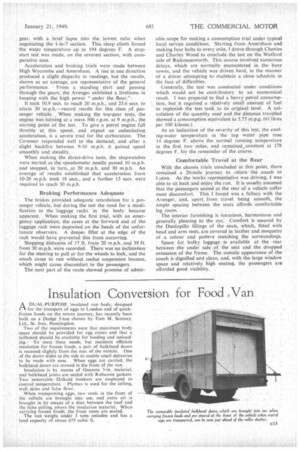SMART, ABLE and
Page 16

Page 17

Page 18

Page 19

If you've noticed an error in this article please click here to report it so we can fix it.
SWIFT -1] • Avenger•
...
THE high power-to-weight ratio of the Commer Avenger underfloor-engined passenger chassis suggests brisk and effortless performance. The results of a 90-mile test of this chassis, fitted with a Harrington .3l-seater coach body, proved the acceleration to be up to expectations, and the excellent suspension and other features of design made the journey smooth, quiet and comfortable.
Although a full-forward-control model, with the driver sharing the passenger compartment, there is a marked absence of engine and gearbox noise in the saloon, the location of the engine and transmission and the floor obviating any possible annoyance from that cause.
The power unit is the Commer 109 b.h.p. overheadvalve petrol engine, inclined in the chassis at an angle of 66 degrees from the vertical. There are many details in its design which have been incorporated to give longevity. Its cylinder bores are treated with a porous,chrome deposit by the Listard process (tinder Van de Horst patents), and the barrels completely waterjacketed throughout their length.
Engine Design The crankshaft, with integral counterweights to promote smooth running and long bearing. life, is retained. in large-diameter Steel-backed babbitAined bearings: All the valves are of silicon-chrome Steel, and. the head: casting is constructed to afford jet cooling to.the valve seats. A by-pass thermostat, in the water-cooling system, gives unrestricted circulation between 185 and
194.degrees-F
Pressure lubrication is provided to the bearings, camshaft and valve gear, and surplus oil from the rockers is used to lubricate the push-rods and tappets. : Smallholes drilled in the trailing edge of the connecting-rod big-ends supply oil intermittently, to -the cylinder Walls. There is a gauge on the facia panel, Which registers the quantity of oil in the-surifp, thus" dispensing with the need for moving the driving seat _arid engine cover to reach the conventional dipstick..
It takes Approximately a minute to 'remove the covers to reach the engine components and auxiliaries; which are conveniently arranged for easy maintenance. With the power unit positioned immediately below floor level, • he fitter can reach the parts with comfort. Operation c8
has already shown that., the engine has a long life before requiring overhaul. When such an occasion does arise, the engine may best be removed .by lowering it forward between the front axle and the frame crossmember.
The four-speed gearbox, combined with the engine and clutch to form a unit, is remotely controlled. from a central selector lever, TO reduce possible noise, and provide swift and easy manipulation, the third and top ratios incorporate helical constAnt-mesh gears which are dog engaged. The Borg and .Beck single-dry-plate clutch is constructed for.. heavy 'duty and requites no lubrication or internal adjustment.
• Layrub large-diameter universal couplings ensure a smooth.take-up of torque, and offer a further advantage of requiring no lubrication. The spiral-bevel final-drive unit, is housed in a substantial cast-steel casing, and is offset to suit the transmission line. It has a straddle— Mountedpinion and crown wheel; and a four-pin differential carrier.
Good braking is attained by employing the Girling two-leading-shoe system on all four wheels, operated through a Clayton Dewandre-Lockheed unit. During . .
thejest I found the braking power directly proportional to pedal pressure, giving efficiency with little effort. • My course, for the Avenger test, included some rough road surfaces, as well as normal main-road travel, and • I found the suspension system .equal to all occasions. The long reverse-cambered semi-elliptic springs, assisted by large shock iibsOrbers and low-pressure tyres:. smoothed out rough 'surfaces and provided stability
when cornering: • • . .
The Model supplied for the test was equipped with
a: 31-seater body,. which was loaded with sandbags to represent a full complement of passengers and luggage. Driving first to the weighbridge. I found that the total weight of S tons was Well distributed between the two axles, a factor which is all-important to driving safety and comfortable riding.
Leaving the Commer works at Luton, a coiirse was steered towards Dunstable and Ivingtioe. The works representative, handling the Avenger with confidence, increased speed to 50 m.p.h. on the Dunstable road, and proceeded to overtake other vehicles without effort. I changed places with him after passing through •
Dunstable, and drove over the rough stretch of road whieh extends towards Ivinghoe.
As far as riding comfort is concerned, passengers would have enjoyed a smooth journey over this stretch, and I varied the road speed from 20-50 m.p.h. fully to check the suspension. Although normal road irregularities could not be felt on the steering. I discovered a slight tremor at 40 m.p.h. when driving over the catseye reflectors in the centre of the road. When driving on cobbled surfaces, later in the day, the steering was steady and without trace of shudder.
The 18-in, steering wheel, although sufficient for light control,. looks small in the general arrangement of the cab. For good appearance, 1 would prefer a wheel of larger diameter, which would also probably smooth out the steering tremor experienced when running over the reflectors.
1 was forced to comment on the position of the handbrake lever, which requires considerable movement on the part of the driver for its operation. If the vehicle be used on long-distance work, with comparatively .few halts. -there is less excuse for criticism than if the machine be required for bus service. 1 learned that the driving position of this particular vehicle was several inches higher than that advocated by the chassis manufacturer. Alterations have been made to the steering to accommodate the raised seat.
The A41 London-Oxford Road was joined at Aston Clinton, and a fuel trial was made over a seven-mile c10 stretch into Aylesbury. Because the Avenger chassis is available for bus or coach work, I decided to make the trials severe by testing it as a stage carriage.
Stops of 15-sec. duration were made in every mile to simulate operation between towns and villages. I found that under these conditions a consumption equivalent to 9.26 m.p.g. (32.4 litres per 100 kilorns.) could be expected. On long-distance coach operation, a fuel return of 13-14 m.p.g. (20 litres per 100 kiloms.) should reasonably be obtained,
After this test Tdrove to Thame in search of cobbled streets to try the chassis under conditions coMparable with those found in Brussels and other parts of the Continent. Although there are cobble setts in Thome. they are laid with meticulous care and without subsidences, which are frequently experienced with the softer foundations of some of the overseas highways It was over such surface that the coach was tried, and there was no unpleasant wheel hammering or tyre noise.
The next objective was Kop Hill, which entailed a short detour from Princes Risborough. This hill presented a *-mile climb of 1 in 10 average gradient, which was tackled from a standing start. Because.of the low atmospheric temperature (47 degrees F.), the shutter had been fitted over the lower part of the radiator, keeping the water temperature at a steady 164 degrees F for normal running.
For the major part the climb was made in second
gear, with a brief . lapse into the. lowest ratio. when negotiating the 1-in-7 section. This steep climb forced 'the water temperature up to 194 degrees F. A stop. start test was made, on the severest section, with comparative ease.
Acceleration and braking trials were made between High Wycomb.e.and Arnersham. A rise in one direction produced a slight disparity in readings, but the results, Shown as an average; are representative of the general performance. • From a standing start and passing through the gears; the Avenger exhibited a liveliness' in keeping with the high power "under the floor::: It took 10.9 sees. to reach 20 m.p.h.,. and 21.6 secs, to attain 30 'rn.p.h.—reCord results for this class of passenger .vehicle. When .making the topLgear tests, the engine. was turning at a mere 500 r.p.m. at 9 m.p.h., the starting point of the test. To give a petrol engine full throttle at this speed, and ekpect an unhesitating acceleration, is a severe trial for the carburation. The Cornmer responded well td the demand, and after a slight backfire between 9-10 m.p.h. ,it gained speed smoothly and. steadily.
When making the direct-drive tests, the stopwatches were started as the speedometer needle passed 10 m.p.h. and stopPed, in turn, ,at 20 m.p.h.. and 30 m.p.h. An average of results established that acceleration from 10-20 m.p.h. took 18 secs., and a further 15 secs. were required to reach 30 rn.p.h.
Braking Performance Adequate
The brakes provided adequate retardation for a passenger vehicle, but during the test the need for a modification to the luggage racks in the body, became apparent. When making the first trial, with an emergencyapplication, the cases at the forward end of the luggage .rack were deposited on the heads of the unfortunate observers. A deeper fillet at the edge of the rack would have prevented this from occurring. Stopping distances of 17 ft. from 29 m.p.h._and 39 ft. from 30 m.p.h. were recorded. There was no inclination for the steering to pull or for the wheels to lock, and the coach came to rest without undue suspension bounce, which might cause discomfort to the passengers.
The, next part of the route showed promise of admir able scope for making a consumption trial under typical local service conditions. Starting from Amersharn and making four halts to every mile, I drove through Chenies and Chorley Wood to conclude the test on the Watford side of Riekmansworth. This course involved numerous • delays, which are normally encountered in the busy towns, and the vehicle was driven hard, in the manner of a driver attempting to maintain a close schedule in the face of difficulties.
Generally, the test was conducted under conditions which would not be contributory to an economical result. I was prepared to find a heavy petrol consump. tion, but it required a relatively small amount of fuel to replenish the test tank to its original level. A calculation of the quantity used and the distance travelled showed a consumption equivalent to 5.75 m.p.g. (61 litres per. 100 kiloms.).
As an indication of the severity of this test, the cooling-water temperature in the top water pipe rose 14 degrees F. aboVe the normal running temperature in the first two miles, and remained_ constant at 178 degrees F. for the remainder of the course.
Comfortable. Travel at the' Rear With the chassis trials concluded at this point, there remained a 20-mile journey to return the coach to Luton. As the works representative was driving, I was able to sit back and enjoy the run. It is usually assumed that the passengers seated at the rear of a vehicle suffer most discomfort. This I found was a fallacy with the Avenger, and, apart from travel being smooth, the ample„ spacing between the seats affords comfortable leg room. ,
The interior furnishing is luxurious, harmonious and generally pleasing to the eye. Comfort is assured by the Dunlopillo fillings of the seats, which, fitted with head and arm rests, are covered in, leather and moquette of a colour and pattern matching the surroundings. Space for bulky luggage. is available at the -rear .between the under side of the seat and the dropped ,extension of the frame. The outside appearance of the coach is dignified and clean, and, with the large window space and relatively high seating, the passengers are afforded good visibility.




























